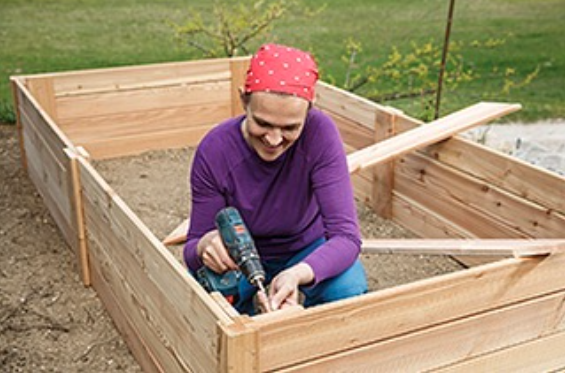Sarasota Insurance Agency >> blog

Want to grow fresh vegetables and flowers but don’t have a lot of room? Learn how to build a do-it-yourself raised garden bed. This project can maximize your backyard garden space, give you better control over the soil, reduce soil compaction and make caring for your plants easier.
Product costs, availability and item numbers may vary online or by market.
Building and planting a raised garden bed is an intermediate-level do-it-yourself project that generally takes a day or so to complete. It’s helpful to have some experience with DIY work and to be familiar with basic carpentry. The general steps for the project include:
We'll show you each of the phases of the work below and give you some tips for planting your raised garden.
Shop our weekend projects and see other options for building a raised bed, such as raised garden bed made with block and lumber and a garden bed kit complete with a raised bed, plants, soil and more.
The work will go more quickly if you have the right tools and materials ready to go. Here are the key items you'll need.
Pick a spot for your garden bed. Keep in mind many types of plants — such as vegetables — need plenty of sun. Take a look at our article and videos on designing and planting a vegetable garden for tips on choosing a good location.
The bed frame can be as simple as 2-by-4s on top of the ground, or even patio retaining wall blocks. The size is up to you. A bed that's at least 6 inches high provides ease of access and gives roots plenty of room to grow. These instructions describe building a 4-foot by 6-foot by 10-1/2-inch bed with untreated 2-by-4s. Untreated lumber isn't rot-resistant, but it's a good option for edibles.
Measure and mark the length of the walls and cut the boards. Measure and cut 2-by-4s for corner posts to support the walls. They should be the height of the garden bed wall. You can also cut posts to install along the walls for additional strength.
For our frame, we cut six 6-foot boards, six 3-foot 9-inch boards and ten 10-1/2-inch support posts. You can build this bed with ten 10-foot 2-by-4s.
Mark the location for your garden bed and remove the grass from this area. You can then add the finishing touches to the frame.
Place the frame in position and outline it with a shovel. Setting up the bed on the ground rather than a hard surface — such as concrete — allows proper root growth and drainage.
A large frame is heavy and unwieldy. You may need a helper when it's time to move it.
Start with high-quality soil and choose plants that'll work in the location you select. Plant tags show details on the care and conditions the plants need to thrive. See our guide to reading a plant tag to learn how plant tags can help you plant and grow a garden.
Fill the bed with a mix of nutrient-rich soil and compost. Use our Mulch and Soil Calculator to estimate the amount you need, and see our article on soil and soil amendments and learn how to improve your soil.
The best time to water is morning when less water evaporates in the sun. Read our watering tips for more ideas, and check the plant tags for additional recommendations.
A water timer on a soaker hose can make a simple task like watering even easier. Drip irrigation can also be an efficient way to get the right amount of water exactly where you need it.
There are a few things you can do to customize this DIY project to suit your gardening plans.
The wood you choose to use for a raised bed is your decision. Here are some options:
Compared to untreated wood, pressure-treated lumber lasts longer and is available at a comparable cost. Some types are specifically treated for ground contact. But keep in mind that even water-based treatments, such as ACQ, contain the fungicide and pesticide necessary to make it effective. Here are some practices that may address concerns about using it in raised beds.
Follow these guidelines and safety precautions anytime you use pressure-treated lumber:
Guidelines
Safety
Read more about pressure-treated lumber and wood preservatives on the EPA website: Overview of Wood Preservative Chemicals.
Growing raised-bed vegetables, fruits and herbs offers several advantages over growing them in regular soil. The soil in a raised bed is looser and will drain better than it would in an in-ground garden. You can also better control soil additions, like compost and fertilizers, to suit your plants’ needs. And, because you’re putting bagged soil into the bed, you can plant immediately, rather than waiting on ground soil to thaw before you can plant in it. Here are some planting suggestions for your garden bed:
2023-07-18 09:19:21